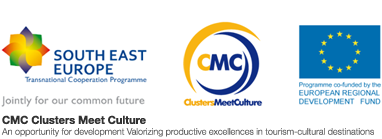Stakeholder’s point of view: an interview with Orsolya Gráf, cultural expert communication and marketing manager, Pannon Philharmonic Orchestra.
According to your opinion, a cluster needs to be formally recognized?
Yes, anyway, because the clusters are beyond of the frame of civil cooperation. For the effectively collaboration of the cluster member companies, nonprofit organizations, there is a need for a common management which has the knowledge, is familiar with the possibilities of the different actors and fills in the moderator and colligate role.
Which are the main obstacles hindering clustering? What are the main success achieved?
As I see, the main obstacle is the absence of culture in collaboration, which is unfortunately supplemented with the lack of time and lack in knowledge of other cooperation areas. The sustainable and long-term cooperation requires investment from all parties besides requires abandonment from parties, because not only one partner would be successful, and not in short term.
How strong is creative and cultural industry in your region? How would you define it?
Compared to other industry segments presence, the pressures and expectations are significant in the field of creative and cultural industry, but to have a functioning creative and cultural industry, we need conceptual decisions, economic and industrial development. In my opinion, the impact of creative and cultural industry on economy and workplace creation in not sufficiently significant. There is absent in activities of other industries, which can support creative and cultural industries in the region.
How strong is tourism in your region and what development potentials can you see?
Over the past few years – mainly owing to the investments of the European Capital of Culture in 2010 – thanks to stronger domestic tourism and regeneration of Pécs the tourism in the city increases. As I see the development opportunities have several stages. First, the city should assess the cultural and natural values which are at disposal and may find the unique tourist attraction. In medium- and longterm the city have to make decisions financing, developing and in protecting questions. The city have to focus on the most excellent places, because it’s necessary to separate the cultural features of urban existence, which haven’t got their own tourist attraction – such as theatre – and those tourist attractions which have there own cultural values – such as the Zsolnay Cultural Quarter , the Kodály Centre, World Heritage sites or the mountain Mecsek. After the separation it should be examined, in point of tourism trends and expectations, what is the lacking point in infrastructure or other aspects of the city’s supply, and due to that the existing values couldn’t be sufficiently exploit. In my view for example, any city in XXI century without spa investments can’t have more guest-nights, and the main street unpeopled looks specifically frightful for tourists. Following a strategy, a city marketing concept and a brand -building – based on technical grounds - are required, as well as the participants cooperation.
In your opinion, are enterprises from the productive sector (industry) linked with the culture?
It could be basically connected. Not only as sponsor - although that linking point is very significant – but as a customer of the cultural industry. Just think of the creatively, graphic and web specialists, audio specialists, etc. who are working on marketing sector. The most significant role is the creation of workplaces, because it causes the increasing of the purchasing power on local level, which have shown by the cultural sector’s consumers. The major investments in industrial and production sectors stimulates the economic and indirectly produce the small businesses upturn, which lead to they appearance as a customer in local creative industry.
Are donations to cultural activities from the private sector strongly developed (mecenate)?
Nowadays the private sectors support of culture and the role of supporting unfortunately continue to decrease. However, in the area of co-operation there are opportunities. If the private sector knows the cultural services “market”, it can use it as a customer, in frame of a partnership in the field of developing. For example a conference in Pécs: ordering a symphony orchestra concert supports the band, moreover raise the rank of the business with the specific program.
Do you think Private public partnership could be a good tool to promote an integrated tourism promotion of the territory?
I think that without partnership the integrated tourism promotion can’t be achieved. Due to the nature and high cost structure of cultural field, public involvement is necessary. However, this role provides the opportunity for cultural offerings. But this is not sufficient in a good sense of profiting. Cultural products financed by public sector build up attraction for turictic products, but private sector should help this exploited and operate consciously. The government’s role can’t be enough. The public and private sectors should work in symbiosis to create a successful, integrated tourism and positive economic outputs, and to develop a city brand. In order to get profit from cooperation along their own interests both sides must make investments.
What do you expect from the CMC project?
I expect an international knowledge and experience, which can be used to obtain assistance for local tourism, cultural actors and producers in questions: how they can work together in local level in order to offer attractive tourist packages and change the everyday’s, not take the cooperation as wasting of time, but actually deal with the operators as investment.

